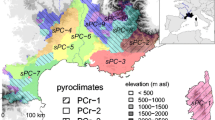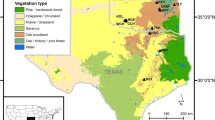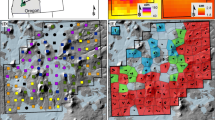Abstract
Fire regimes are complex systems that represent an aggregate of spatial and temporal events whose statistical properties are scale dependent. Despite the breadth of research regarding the spatial controls on fire regime variability, few datasets are available with sufficient resolution to test spatially explicit hypotheses. We used a spatially distributed network of georeferenced fire-scarred trees to investigate the spatial structure of fire occurrence at multiple scales. Mantel’s tests and geostatistical analysis of fire-occurrence time series led to inferences about the mechanisms that generated spatial patterns of historical fire synchrony (multiple trees recording fire in a single year) in eastern Washington, USA. The spatial autocorrelation structure of historical fire regimes varied within and among sites, with clearer patterns in the complex rugged terrain of the Cascade Range than in more open and rolling terrain further north and east. Results illustrate that the statistical spatial characteristics of fire regimes change with landform characteristics within a forest type, suggesting that simple relationships between fire frequency, fire synchrony, and forest type do not exist. Quantifying the spatial structures in fire occurrence associated with topographic variation showed that fire regime variability depends on both landscape structure and the scale of measurement. Spatially explicit fire-scar data open new possibilities for analysis and interpretation, potentially informing the design and application of fire management on landscapes, including hazardous fuel treatments and the use of fire for ecosystem restoration.



Similar content being viewed by others
Notes
High resolution graphics of topographic complexity for the seven sites are available from the corresponding author. These provide a point of departure, albeit qualitative, for such a multi-scale analysis.
References
Agee JK (1993) Fire ecology of Pacific Northwest forests. Island Press, Washington, DC
Agee JK (1994) Fire and weather disturbances in terrestrial ecosystems of the eastern Cascades. USDA Forest Service, General Technical Report PNW-320, Pacific Northwest Research Station, Portland, OR
Agee JK, Skinner CN (2005) Basic principles of forest fuel reduction treatments. For Ecol Manage 211:83–96
Allen CD, Falk DA, Suckling KF, Swetnam TW, Schulke T, Stacey PB, Morgan P, Hoffman M, Klingel JT (2002) Ecological restoration of southwestern ponderosa pine ecosystems: a broad perspective. Ecol Appl 12:1418–1433
Arno SF, Sneck KM (1977) A method for determining fire history in coniferous forests of the mountain west. USDA Forest Service Gen Tech Rep INT-GTR-42. Intermountain Research Station, Ogden, UT
Baker WL (1989) Effect of scale and spatial heterogeneity on fire-interval distributions. Can J For Res 19:700–706
Bailey RG (1996) Ecosystem geography. Springer-Verlag, Inc., New York, NY, 216 p
Barrett SW (1980) Indians and fire. Western Wildl 6:17–21
Brown JK, Smith JK (eds) (2000) Wildland fire in ecosystems: effects of fire on flora. USDA Forest Service Gen. Tech. Rep. RMRS-GTR-42-vol. 2. Rocky Mountain Research Station, Ogden, UT, 257 p
Cliff AD, Ord JK (1981) Spatial processes: models and applications. Pion Ltd., London
Cressie N (1985) Fitting variogram models by weighted least squares. Math Geol 17:563–568
Daly C, Neilson RP, Phillips DL (1994) A digital topographic model for distributing precipitation over mountainous terrain. J Appl Meteorol 33:140–158
Dieterich JH, Swetnam TW (1984) Dendrochronology of fire-scarred ponderosa pine. For Sci 30:238–247
Dutilleul P (1998) From forest stands to landscapes: spatial scales and the roles of disturbances. In: Peterson DL, Parker VT (eds) Ecological Scale. Columbia University Press, New York, USA, pp 369–386
Dorner B, Lertzman K, Fall J (2002) Landscape pattern in topographically complex landscapes: issues and techniques for analysis. Landsc Ecol 17:729–743
ESRI (2006) ArcGis. Version 9.0. Environmental Systems Research Institute, Inc., Redlands, CA
Everett RL, Schelhaas R, Keenum D, Spubeck D, Ohlson P (2000) Fire history in the ponderosa pine/Douglas-fir forests on the east slope of the Washington Cascades. For Ecol Manage 129:207–225
Falk DA, Miller CM, McKenzie D, Black AE (2007) Cross-scale analysis of fire regimes. Ecosystems 10:809–826
Feder J (1988) Fractals. Plenum Press, New York
Fortin M-J, Payette S (2002) How to test the significance of the relation between spatially autocorrelated data at the landscape scale: a case study using fire and forest maps. Ecoscience 9:213–218
Franklin JF, Dyrness CT (1988) Natural vegetation of Oregon and Washington. Oregon State University Press, Eugene, Oregon, USA
Gedalof ZM, Peterson DL, Mantua NJ (2005) Atmospheric, climatic, and ecological controls on extreme wildfire years in the northwestern United States. Ecol Appl 15:154–174
Goovaerts P (1997) Geostatistics for natural resources evaluation. Oxford University Press, New York
Hann WJ, Strohm DJ (2003) Fire regime condition class and associated data for fire and fuels planning: methods and applications. In: Omi PN, Joyce LA (eds) Proceedings of the 2002 conference on fire, fuel treatments, and ecological restoration. USDA Forest Service Proceedings RMRS-P-29, Rocky Mountain Research Station, Fort Collins, CO, pp 227–443
Hessl AE, McKenzie D, Schellhaas R (2004) Drought and Pacific Decadal Oscillation linked to fire occurrence in the inland Pacific Northwest. Ecol Appl 14:425–442
Hessl AE, Miller J, Kernan J, McKenzie D (2007) Mapping wildfire boundaries from binary point data: comparing approaches. Prof Geographer 59:87–104
Heyerdahl EK, Brubaker LB, Agee JK (2001) Spatial controls of historical fire regimes: a multiscale example from the interior West, USA. Ecology 82:660–678
Heyerdahl EK, McKenzie D, Daniels LD, Hessl AE, Littell JS, Mantua NJ. Climate drivers of regionally synchronous fires in the inland Northwest (1651–1900). Int J Wildland Fire (in press)
Insightful, Inc. S-PLUS v. 6.0. (2000) Seattle, WA, USA
Isaaks EH, Srivastava RM (1989) An introduction to applied geostatistics. Oxford University Press, New York, USA
Johnson EA, Gutsell SL (1994) Fire frequency models, methods, and interpretations. Adv Ecol Res 25:239–287
Jordan GJ, Fortin M-J, Lertzman KP (2005) Assessing spatial uncertainty associated with forest fire boundary delineation. Landsc Ecol 20:719–731
Kitzberger T, Brown PM, Heyerdahl EK, Swetnam TW, Veblen TT (2006) Contingent Pacific-Atlantic Ocean influence on multicentury wildfire synchrony over western North America. Proc Nat Acad Sci doi:10.1073/pnas.060607810410.1073/pnas.0606078104
Legendre P, Fortin M-J (1989) Spatial pattern and ecological analysis. Vegetatio 80:107–138
Legendre P, Legendre, L (1998) Numerical ecology, Second English Edition. Elsevier Science B.V., Amsterdam, Netherlands
Legendre P, Troussellier M (1988) Aquatic heterotrophic bacteria: modeling in the presence of spatial autocorrelation. Limnol Oceanogr 33:1055–1067
Lertzman K, Fall J (1998) From forest stands to landscapes: spatial scales and the roles of disturbances. In: Peterson DL, Parker VT (eds) Ecological scale. Columbia University Press, New York, USA, pp 339–367
Malamud BD, Morein G, Turcotte DL (1998) Forest fires: an example of self-organized critical behavior. Science 281:1840–1842
Mantel N (1967) The detection of disease clustering and a generalized regression approach. Cancer Res 27:209–220
McKenzie D, Gedalof Z, Peterson DL, Mote P (2004) Climatic change, wildfire, and conservation. Conserv Biol 18:890–902
McKenzie D, Hessl AE, Kellogg L-KB (2006a) Using neutral models to identify constraints on low-severity fire regimes. Landsc Ecol 21:139–152
McKenzie D, Kellogg L-KB, Falk DA, Miller CM, Black AE (2006b) Scaling laws and fire-size distributions in historical low-severity fire regimes. Geophys Res Abs 8:1607–7962/gra/EGU06-A-01436
Moritz MA, Morais ME, Summerell LA, Carlson JM, Doyle J (2005) Wildfires, complexity, and highly optimized tolerance. Proc of Nat Acad Sci (USA) 102:17912–17917
Oden NL, Sokal RR (1992) An investigation of three-matrix permutation tests. J Classification 9:275–290
Robbins WG (1999) Landscape and environment: ecological change in the Intermontane Northwest. In: Boyd R (ed) Indians, fire, and the land in the Pacific Northwest. Oregon State University Press, Corvallis, OR, pp 219–237
Robbins WG, Wolf DW (1994) Landscape and the intermontane Northwest: an environmental history. USDA Forest Service General Technical Report PNW-GTR-319, Pacific Northwest Research Station, Portland, OR
Schmidt KM, Menakis JP, Hardy CC, Hann WJ, Bunnell DL (2002) Development of coarse-scale spatial data for wildland fire and fuel management. United States Department of Agriculture, Forest Service, Rocky Mountain Research Station, Gen Tech Rep RMRS-GTR-87. Fort Collins, Colorado, USA
Smouse PE, Long JC, Sokal RR (1986) Multiple regression and correlation extensions of the Mantel test of matrix correspondence. Systematic Zool 35:627–632
Sorensen T (1948) A method of establishing groups of equal amplitude in a plant based on similarity of species content and its applications to analysis of vegetation on Danish commons. Biol Skr 5:1–34
Swetnam TW, Betancourt JL (1999) Mesoscale disturbance and ecological response to decadal climatic variability in the American Southwest. J Climate 11:3128–3147
Swezy DM, Agee JK (1991) Prescribed-fire effects on fine-root and tree mortality in old-growth ponderosa pine. Can J For Res 21:626–634
Tande GF (1979) Fire history and vegetation pattern of coniferous forests in Jasper National Park, Alberta. Can J Bot 57:1912–1931
Taylor AH, Skinner CN (1998) Fire history and landscape dynamics in a late-successional reserve, Klamath Mountains, California, USA. For Ecol Manage 44:1–17
Taylor AH, Skinner CN (2003) Spatial and temporal patterns of historic fire regimes and forest structure as a reference for restoration of fire in the Klamath Mountains. Ecol Appl 13:704–719
Turcotte DL (1989) Fractals in geophysics. Pure Appl Geophys 131:171–196
Veblen TT, Kitzberger T, Donnegan J (2000) Climatic and human influences on fire regimes in ponderosa pine forests in the Colorado Front Range. Ecol Appl 10:1178–1195
Wagner HH (2003) Spatial covariance in plant communities: integrating ordination, geostatistics, and variance testing. Ecology 84:1045–1057
Wang H, Hall CHS, Cornell JD, Hall MHP (2002) Spatial dependence and the relationship of soil organic carbon and soil moisture in the Luquillo Experimental Forest, Puerto Rico. Landsc Ecol 17:671–684
Webster R,Oliver MA (2001) Geostatistics for environmental scientists. Wiley, New York
Acknowledgments
This paper is dedicated to the memory of Lara-Karena Kellogg. She was orders of magnitude larger than life and continues to inspire us in both our work and our daily lives. We thank Robert Norheim for help with cartography and Marie-Josée Fortin and two anonymous reviewers for their comments on an earlier draft of this manuscript. Research was supported by the Pacific Northwest Research Station, USDA Forest Service, and by an award from the Joint Fire Sciences Program (No. 01-1-6-01) under a cooperative agreement between the USDA Forest Service and the University of Washington (PNW 02-CA-11261987-071).
Author information
Authors and Affiliations
Corresponding author
Rights and permissions
About this article
Cite this article
Kellogg, LK.B., McKenzie, D., Peterson, D.L. et al. Spatial models for inferring topographic controls on historical low-severity fire in the eastern Cascade Range of Washington, USA. Landscape Ecol 23, 227–240 (2008). https://doi.org/10.1007/s10980-007-9188-1
Received:
Accepted:
Published:
Issue Date:
DOI: https://doi.org/10.1007/s10980-007-9188-1




